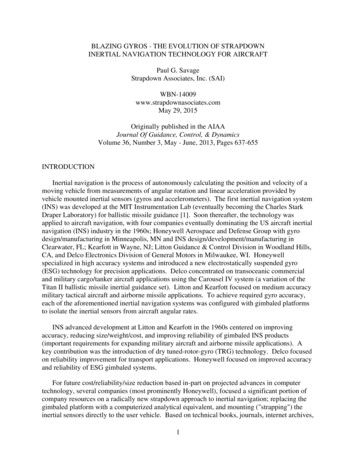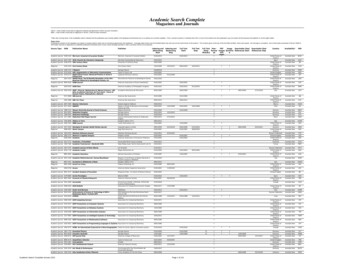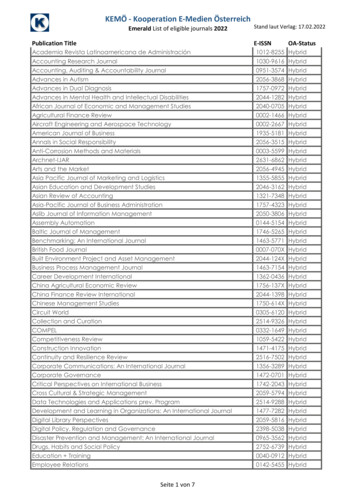
Transcription
BLAZING GYROS - THE EVOLUTION OF STRAPDOWNINERTIAL NAVIGATION TECHNOLOGY FOR AIRCRAFTPaul G. SavageStrapdown Associates, Inc. (SAI)WBN-14009www.strapdownasociates.comMay 29, 2015Originally published in the AIAAJournal Of Guidance, Control, & DynamicsVolume 36, Number 3, May - June, 2013, Pages 637-655INTRODUCTIONInertial navigation is the process of autonomously calculating the position and velocity of amoving vehicle from measurements of angular rotation and linear acceleration provided byvehicle mounted inertial sensors (gyros and accelerometers). The first inertial navigation system(INS) was developed at the MIT Instrumentation Lab (eventually becoming the Charles StarkDraper Laboratory) for ballistic missile guidance [1]. Soon thereafter, the technology wasapplied to aircraft navigation, with four companies eventually dominating the US aircraft inertialnavigation (INS) industry in the 1960s; Honeywell Aerospace and Defense Group with gyrodesign/manufacturing in Minneapolis, MN and INS design/development/manufacturing inClearwater, FL; Kearfott in Wayne, NJ; Litton Guidance & Control Division in Woodland Hills,CA, and Delco Electronics Division of General Motors in Milwaukee, WI. Honeywellspecialized in high accuracy systems and introduced a new electrostatically suspended gyro(ESG) technology for precision applications. Delco concentrated on transoceanic commercialand military cargo/tanker aircraft applications using the Carousel IV system (a variation of theTitan II ballistic missile inertial guidance set). Litton and Kearfott focused on medium accuracymilitary tactical aircraft and airborne missile applications. To achieve required gyro accuracy,each of the aforementioned inertial navigation systems was configured with gimbaled platformsto isolate the inertial sensors from aircraft angular rates.INS advanced development at Litton and Kearfott in the 1960s centered on improvingaccuracy, reducing size/weight/cost, and improving reliability of gimbaled INS products(important requirements for expanding military aircraft and airborne missile applications). Akey contribution was the introduction of dry tuned-rotor-gyro (TRG) technology. Delco focusedon reliability improvement for transport applications. Honeywell focused on improved accuracyand reliability of ESG gimbaled systems.For future cost/reliability/size reduction based in-part on projected advances in computertechnology, several companies (most prominently Honeywell), focused a significant portion ofcompany resources on a radically new strapdown approach to inertial navigation; replacing thegimbaled platform with a computerized analytical equivalent, and mounting ("strapping") theinertial sensors directly to the user vehicle. Based on technical books, journals, internet archives,1
discussions with past colleagues, but mostly from my direct experience and personal records, thisarticle describes the curious and sometimes convoluted path by which the Honeywell strapdownprogram eventually led to development of the ring laser gyro (RLG) strapdown INS, andconversion from gimbaled to strapdown technology throughout the airborne inertial navigationindustry.For technical background, the article first discusses the concept of inertial navigation usinggimbaled versus strapdown system implementations. Angular rotation sensors (gyros), the keyinstruments in inertial systems, are briefly described and compared for the strapdown approachesconsidered along the way. The Honeywell GG1300 RLG is described in more detail, the firstRLG to meet aircraft strapdown INS accuracy and reliability requirements. Most of the articlefocuses on the interrelationships and testing of four Honeywell strapdown inertial systemsdeveloped in the early through mid 1970s; ATIGS (Advanced Tactical Inertial Guidance System)and LINS (Laser Inertial Navigation System) using the GG1300; RLGN (Ring Laser GyroNavigator) and its derivative Laser IRS (Inertial Reference System) prototype using a newsmaller size Honeywell GG1342 RLG, the latter known at Honeywell as the 7x7 strapdownsystem. Flight testing of the four Honeywell systems is described; ATIGS by the US Navy'sNaval Weapons Center (NWC), LINS by the US Air Force Central Inertial Guidance TestFacility (CIGTF) at Holloman Air Force Base, RLGN by the US Navy's Naval Air DevelopmentCenter (NADC), and the 757/767 Laser IRS prototype by the Boeing Airplane Company. Theproposal process for the new Boeing 757/767 commercial airplane strapdown IRS is alsodiscussed that, with Laser IRS prototype flight test results, led to the selection of Honeywell forthe multi-year 757/767 IRS large scale procurement contract, the first for both aircraft strapdowninertial systems and for ring laser gyros. The article concludes with an epilogue of how theHoneywell and Boeing programs soon led to the general conversion from gimbaled to strapdownsystem technology throughout the entire aircraft inertial navigation industry.ACRONYMSAFAL - US Air Force Avionics Laboratory, Wright Patterson Air Force Base, Dayton, OHATIGS - Advanced Tactical Inertial Guidance SystemCEP - Circular Error Probable (Radius of a circle containing 50% of horizontal radial positionerror samples).CIGTF - US Air Force Central Inertial Guidance Test Facility, Holloman Air Force Base,Alamogordo, NM.3F - Form-Fit-Function standardized US Air Force interface specification for INSinterchangeability between different suppliers.INS - Inertial Navigation System with position, velocity, attitude, heading, etc. outputs. Incommercial application parlance, also includes guidance steering outputs based on aninput waypoint defined flight profile).IRS - Inertial Reference System (In commercial application parlance, a strapdown INS withposition, velocity, attitude, heading, etc. outputs but without guidance steering outputs).IRU- Inertial Reference Unit (an INS in general)ISA - Inertial Sensor AssemblyLASER - Light Amplification by the Stimulated Emission of Radiation2
LINS - Laser Inertial Navigation SystemMIT - Massachusetts Institute of TechnologyMICRON - Micro NavigatorNADC - US Naval Air Development Center, Warminster, PANWC - US Naval Weapons Center, China Lake, CARIG - Rate Integrating GyroRLG - Ring Laser GyroRLGN - Ring Laser Gyro NavigatorTRG - Tuned Rotor GyroZLG - Zero-Lock Laser GyroENGINEERING UNIT NOTATIONarc-sec - Arc second, a unit of angular measurement (3,600 in one degree)deg - Degreesdeg/rt-hr - Degrees per square root of hourfps - Feet per secondhr - Hourmicron - 0.000001 metersmilli-g - 0.001 gs (1 g 32.2 feet per second per second)min - Minute (of time)nmph - Nautical miles per hourGIMBALED VERSUS STRAPDOWN SYSTEM IMPLEMENTATION APPROACHESInertial sensors in a gimbaled inertial navigation system (INS) are orthogonally mounted to acommon base ("platform") surrounded by concentric gimbals, interconnected to the platform andeach other through ball-bearing shafts (depicted schematically in Fig. 1, the cylindersrepresenting gyros, cubes accelerometers, input axes dashed). Non-rotation of the Fig. 1 sensorplatform is actively controlled by torque motors mounted on the gimbal shafts, driven by gyrooutput measurements of platform rotation. Four-gimbal platforms (Fig. 1) were typically used inaircraft applications for operation at any vehicle angular orientation while maintaining the threeinner gimbal shafts near perpendicularity (the optimum orientation for minimum gimbal torquemotor size/power requirements under dynamic angular maneuvering).Fig. 2 depicts the interfaces between the gimbaled platform and the INS navigationcomputer. Platform accelerometer outputs in Fig. 2 (vector components along "platform" axes)are processed in the INS computer to calculate velocity and position. Feedbacks from thenavigation computer bias the platform gyros (when allowable for the gyro configuration),commanding the platform to follow prescribed small angular rotation rates; e.g., to maintain alocally-vertical platform orientation relative to the earth in the presence of earth's rotation rateand aircraft translational motion over the earth.3
Fig. 1 - Gimbaled Platform SchematicFig. 2 - Gimbaled Inertial Navigation SystemFig. 3 depicts the classical strapdown approach to inertial navigation. Unlike Fig. 2, theinertial sensor mount in Fig. 3 is directly connected (usually through silicone elastomericisolators) to the vehicle structure ("strapdown"), thereby eliminating the Fig. 2 intermediategimbal/torque-motor assembly.4
Fig. 3 - Rate-Gyro Based Strapdown Inertial Navigation SystemWith minor differences, the navigation computations in Fig. 3 are the same as for thegimbaled INS configuration of Fig. 2. The basic difference is that the specific force accelerationcomponents provided directly from platform accelerometers in Fig. 2 to the NavigationComputations block, are calculated in Fig. 3 with a vector-transformation operation performed inthe system computer. This analytically converts the strapdown accelerometer outputs to thevalues that would be measured from accelerometers mounted on a Fig. 2 gimbaled platform.The second input to the Vector Transformation block in Fig. 3 is the angular orientation(attitude) of the gyro/accelerometer strapdown mount relative to the equivalent Fig. 2 gyrostabilized platform. The attitude data is calculated by high-speed digital integration operationson strapdown rate-gyro inputs. The feedback gyro biasing operation in Fig.1 for commandingplatform rotation rates is also present in Fig. 3, but as part of the attitude computational processso that computed attitude outputs become referenced to Fig. 2 stable "platform axes".Prior to engaging the inertial navigation function, the initial angular orientation of the Fig. 2platform (or Fig. 3 computed attitude) must be established during "initial alignment" operations.Under quasi-stationary conditions, this is a self-alignment function in which the physicalgimbaled platform (or strapdown computed attitude) is controlled to a locally level orientation,based on accelerometer measurements in Fig. 2 (or transformed acceleration measurements inFig. 3). Simultaneously, accelerometer heading relative to true north is ascertained from gyrocontrolled platform accelerometer rates in Fig. 2 (or transformed acceleration rates in Fig. 3) inresponse to earth's rotation rate, based on the fundamental characteristic that the horizontalcomponent of earth rate points north.An alternative to the Fig. 3 Rate-Gyro strapdown approach is to use attitude gyros whoseoutput represents the angular orientation relative to non-rotating inertial space, of the gyro case(hence, the sensor mount to which the gyros are attached). The concept is depicted in Fig. 4.5
Fig. 4 - Attitude-Gyro Based Strapdown Inertial Navigation SystemComparing Fig. 4 with Fig. 3 shows the principal advantage afforded by use of attitudegyros; eliminating Fig. 3 high-speed computation requirements for integrating strapdown angularrates into attitude. For 1960 and early 1970 computer technology limitations, this was animportant advantage. The penalty was the attitude gyro requirement for accurate readoutcapability at any angular orientation of the strapdown sensor mount (fixed to the vehicle). Otheroperations in Fig. 4 parallel those in Fig. 3, but with integration of "Platform Inertial RotationRates" executed at low rate in a separate computation block, then combined with gyro data toform the Fig. 3 "Strapdown To Platform Attitude" data for acceleration transformation. In the1960 - 1970 time frame, only the ESG (with modification for wide-angle readout) had theaccuracy potential for aircraft strapdown INS application.Compared with the traditional gimbaled INS approach, strapdown technology promisedfuture cost reduction and improved reliability through elimination of mechanical parts, gimbalshaft-angle transducers, slip-ringed electrical connections to/from platform components, andhigh-power gimbal-motor drive electronics [2 - 4]. Another strapdown advantage was touted inredundant applications (particularly for the Fig. 3 rate-gyro approach) by using skew-alignedsensor input axis geometries (mounting the inertial sensors in a non-orthogonal arrangementhaving no three input axes coplanar) [3, 5 - 8]. Fig. 3 orthogonal axis angular-rates/accelerationcomponents are then obtained from any set of three or more skewed gyros/accelerometers byanalytical conversion operations in the system computer. As a result, only one additionalgyro/accelerometer is required for each level of system redundancy (in contrast with classicalredundant gimbaled INS configurations requiring a duplicate INS for each redundancy level).For the Fig. 3 rate-gyro implementation, strapdown sensor outputs can also be used for othervehicle functions (e.g., aircraft axis angular-rate/acceleration for flight-control/stabilityaugmentation), thereby reducing the multiplicity of dedicated aircraft inertial sensors normallyrequired for non-INS related functions. (Note - To achieve a consistent redundancy levelthroughout a system, skewed redundant sensors must also be interfaced with equivalentredundancy level computers, power supplies, and cabling designed to also block single failurepropagation between redundant channels.)6
Before strapdown technology could be considered viable, two major technological advanceswere required to achieve accuracy levels already attained in gimbaled INS high-volumeproduction; 1) Computer advances to handle new rate-gyro strapdown INS throughputrequirements, but most importantly, 2) Never-yet achieved gyro accuracies in a non-gimbaledstrapdown dynamic rate environment.The gimbaled platform in an INS exists for two basic reasons; reducing gyro error (as notedpreviously) induced by high input angular rates, and to create a stable mount for theaccelerometers at a known angular orientation relative to the earth (for earth basedposition/velocity determination) [9]. By eliminating the stabilized platform, performancerequirements for strapdown gyros dramatically increase in scale factor accuracy and sensor-tosensor alignment for reduced error build-up under attitude changes. A more subtle requirementfor aircraft systems is the need for long-term stability of critical inertial sensor performanceparameters due to the lack of built-in rotation test equipment (used to measure and compensateinertial sensor performance parameters in a test facility). In a gimbaled INS, rotation calibrationcan be provided by the gimbal assembly during a special test mode. (For the Delco Carouselgimbaled system, the stable platform is used as a base for mounting a synchronously controlledrotating "table" that houses the horizontal sensors. By continuously rotating the table relative tothe stabilized platform at 1 revolution/minute, horizontal accelerometer and gyro biases becomeaveraged, effectively canceling their impact on position/velocity error build-up.) Additionally,normal self-alignment operations prior to navigation mode engagement, implicitly compensatecritical sensor errors in a gimbaled INS. During self-alignment, all inertial navigation systemsdevelop platform tilt and heading errors that cancel horizontal accelerometer and east gyro bias.For gimbaled systems, the cancellation remains after navigation mode entry because the sensorplatform remains at its self-alignment orientation under subsequent vehicle maneuvering. Incontrast, strapdown sensors rotate with the vehicle during navigation, altering their orientationfrom the alignment attitude (the worst case being a 180 deg heading rotation following initialalignment, effectively doubling the impact of the sensor errors).To meet the strapdown performance challenge, major design changes had to be incorporatedin conventional angular-momentum based gyros, and a new angular rate sensor was introduced,the ring laser gyro, based on the relativistic properties of light [10]. (The term "gyro" is nowcommonly used for all angular rate sensing inertial instruments. It derives from "gyroscope", theterm originally used for angular rate sensing based on the gyroscopic angular-momentumproperties of rotating mass.)CONVENTIONAL STRAPDOWN GYRO DEVELOPMENTThe distinguishing characteristic between angular-momentum based gyro configurations isthe method used to contain the spinning rotor without inducing error from spurious torques onthe rotor assembly. Angular-momentum gyros considered during the 1960s for strapdownapplication were the single-degree-of-freedom floated rate integrating gyro (RIG), the two-axisdynamically compensated dry tuned rotor gyro (TRG), and the electrostatically suspended gyro(ESG) [11 - 13, 14 Chapts 7 - 9, 15 Chapt 4]. The RIG (Fig. 5) supports the rotor assembly bythe buoyancy of surrounding viscous fluid. The TRG (Fig. 6) supports the rotor by flexurepivots connected through an intermediate gimbal to the spin-motor shaft. Pivot-flexure spring7
torques on the rotor developed under off-null operation, are thereby compensated by dynamicmotion of the spinning gimbal. The two axis ESG (Fig. 7) supports the free-rotor with anelectrostatic field applied by case-mounted electrodes.The RIG (Fig. 5) measures the integrated difference between input axis angular rate andapplied bias rate, the latter provided by an electrical torquer. The TRG (Fig. 6) measures thetwo-axis angular orientation between the gyro case and rotor. The TRG also contains a torquerassembly for intentionally precessing the spinning rotor axis relative to inertial space. To meetthe strapdown gyro performance challenge, "closed-loop" TRG and RIG configurations had to bedeveloped in which electrical input to the torquers are provided in feedback fashion to maintainpickoff output null. The torquer input command thereby becomes proportional to gyro caseangular rate, and the strapdown rate-gyro output in Fig. 3.Fig. 5 - Single-Degree-Of-Freedom Floated Rate Integrating Gyro (RIG)Fig. 6 - Two-Axis Dry Tuned Rotor Gyro (TRG)8
The ESG (Fig. 7) measures the two-axis angular orientation of the case relative to the rotorwhich, having no accurate torquing means, maintains a fixed angular orientation relative toinertial space. The angular orientation of the case relative to the rotor is determined with the Fig.7 Honeywell hollow-shell ESG rotor approach by measuring the time interval between pick-offsensed light reflections from a scribe pattern etching on the rotor. Rockwell Autonetics Division,Anaheim, CA, a later comer to ESG technology, used a small solid mass-unbalanced rotor togenerate a detectable modulation signature in the suspension electrodes for readout - massunbalance modulation - MUM. [11, 13, 14 Chapt 8] In gimbaled applications, ESG case-to-rotorangular orientation is maintained at the pick-off null by gimbal command rotation. Forstrapdown applications, ESG pickoffs have to be accurate at any case orientation relative to therotor (wide-angle readout) for Fig. 4 attitude-gyro measurements.Fig. 7 - Honeywell Hollow-Shell Rotor Electrostatically Suspended Gyro (ESG)Both RIGs and TRGs required enlarged high rate torquer assemblies and associated precisionelectronics to precess the spinning rotors at high angular rates [11, 16]. Strapdown RIG pivots,originally used for delicate unstressed centering of the floatation supported rotor assembly (Fig.5), now had to withstand severe lateral bearing loads under output axis rotation, therebydistorting output axis integration response. Gas-bearings for improved RIG spin-motorreliability required stiffening for high dynamic angular rate, increasing start-up stiction undersuccessive on-off cycles. The inevitable result was added bias and scale factor error frommechanical stresses under dynamic angular rates, high rate torquer heating, and on-off/cooldown, with long-term bias stability remaining a major limitation in aircraft strapdown INSapplications. ESG modification for strapdown operation introduced new error mechanisms as afunction of vehicle attitude; precision wide-angle readouts generated scale factor error, andincreased bias error was induced from suspension-field forces acting at different case-mountedelectrode/rotor orientations, both effects requiring calibration and increased production cost.With these changes, aircraft strapdown INS requirements also dictated two orders of magnitude9
improvement in RIG/TRG torquer-loop scale-factor accuracy (compared to gimbaled systemrequirements), and 2 arc-sec ESG readout accuracy for arbitrary rotor/case attitude.By the end of the 1960s, strapdown conventional gyros were incapable of meeting generalaircraft strapdown INS requirements without performance specification relief or limiting usageto application areas where reduced INS accuracy was acceptable (e.g., operation with inertialaids to mitigate navigational error buildup or limiting strapdown technology to lower angularrate applications). Additionally, as with gimbaled system conventional gyros, strapdownversions required active temperature control (with heaters) to stabilize thermally sensitiveperformance parameters at compensation-calibrated values. The associated warm-uprequirement precluded a desirable faster INS "reaction time", the time from system turn-on toentry into the navigation mode (including platform initial north alignment determination).Ironically, accelerometer thermally sensitive bias trending during heading alignment wasactually the warm-up time determining factor. For conventional gyros and accelerometersmounted in close proximity, gyro heating becomes a dominant accelerometer thermal inputdriver, requiring accelerometer temperature control (and warm-up) for heated gyro compatibility.RING LASER GYRO DEVELOPMENTTo directly meet the Fig. 3 strapdown rate-gyro challenge from a different perspective, thering laser gyro (RLG) was introduced in 1963. Unlike traditional angular-momentum gyroswhose operation is based on the Newtonian inertial properties of rotating mass, the operatingprinciple for the RLG is based on the relativistic properties of optical standing waves generatedby oppositely directed laser beams contained in a closed optical path [11, 12, 17, 18, 14 Chapt13, 15 Chapt 8].Fig. 8 depicts the basic operating elements in a ring laser gyro; a closed optical cavitycontaining two independent beams, each of single frequency light. The beams travelcontinuously between the reflecting surfaces of the cavity in a closed optical path; one in theclockwise direction, the other counter clockwise, each occupying the same physical space. Thelight beams are sustained by the lasing action of a helium-neon gas discharge within the opticalcavity. The reflecting surfaces are dielectric mirrors designed to selectively reflect the frequencyassociated with the particular helium-neon transition being used. The counter-rotating beamscombine into a standing wave of light that remains inertially fixed as the gyro cavity rotates. Asmall fraction of each beam escapes the cavity, one reflected through a corner prism, bothrecombined on photodiode readout detectors. The corner prism is designed to produce a smallangle between the recombining beams, thereby creating an optical interference fringe pattern onthe photodiodes, each fringe equivalent to a magnified image of the standing wave within thegyro. As the cavity rotates, the fringes traverse the diodes, each fringe corresponding to half thelaser wavelength λ for the equivalent angular rotation of the gyro (λ / D radians), where D is theaverage gyro width (e.g., 2 arc sec of gyro rotation per fringe passage). Photodiode readout logicgenerates digital output pulses for each fringe quarter-wave passage. Two diodes are used,separated from each other by one quarter of a photodiode-sensed fringe so that resulting diodesinusoidal outputs are 90 deg phase separated. Comparison between diode outputs determinesthe direction of rotation, positive or negative, depending on whether one diode output is leadingor lagging the other.10
Fig. 8 - Ring Laser Gyro Operating ElementsLaser stands for Light Amplification by the Stimulated Emission of Radiation. In an RLG,the emission process is provided by the helium/neon gas discharge that generates light waves at adiscrete atomic transition wavelength when impacted by photons of the same wavelength. Forlasing to occur, the RLG mirrors must reflect the emitted light around the closed beam path sothat it returns in phase with itself. The beam intensity will then be amplified into resonance untilthe light emitted ("gain") balances all cavity losses, which then also maximizes beam power.The gain is set by the current magnitude applied to the gas discharge. To satisfy the return-inphase condition for lasing, the beam path length must be controlled to an integral multiple ofdiscrete lengths corresponding to the optical wavelength of the helium/neon discharge. This isachieved implicitly in the RLG by mirror adjustment to a position for peak beam power. Beampower is measured by a photodiode power detector attached to one of the mirror substrates (Fig.8). Piezoelectric transducers attached to the outer mirror substrates (Fig. 8) provide the meansfor actively controlling mirror position, enabling minute adjustments by an electrically appliedvoltage. The control voltage is generated in closed-loop fashion to sustain maximum outputfrom the power detector. In addition to enabling lasing, the path-length-control process alsoproduces two very important angular rate sensing operational benefits; 1) Stabilization of RLGperformance parameters, and 2) Elimination of path length changes from gyro block thermalexpansion.The RLG concept bypassed many of the conventional gyro design issues. Piezoelectrictransducer path-length control eliminated the principle source of thermal error sensitivity withoutrequiring direct temperature control. This important characteristic eliminated the warm-up timepenalty experienced with conventional gimbaled inertial systems. Stable high scale factoraccuracy, the critical performance parameter for strapdown applications, was an inherent quality,11
independent of bias producing mechanisms. Simple wide-angle readouts could be used withminimum impact on accuracy (because 360 deg laser signal detector scaling corresponds to arcsec actual gyro input axis rotation). However, the RLG has a unique "lock-in" error mechanismof its own that cannot be eliminated, and had to be circumvented before RLGs could beconsidered for high accuracy INS application [19].RLG lock-in is caused by imperfections in the laser reflecting mirrors and optical elementsplaced in the beam path that introduce clockwise/counterclockwise beam energy coupling.Beam coupling tends to force the standing wave to follow the cavity rotation (losing its nonrotating inertial property), and producing a "dead-zone" in gyro output at low input rate (e.g.,0.03 deg/sec, depending on mirror quality). The general solution is to artificially bias the gyroinput to avoid dwelling in the lock-in region. RLG design activities in the 1960s centered oncompeting methods for overcoming lock-in, the principle groups involved being SperryGyroscope Division of Sperry Rand, Great Neck, NY; Hamilton Standard Division of UnitedTechnologies, Windsor Locks, CN; and Honeywell Aerospace and Defense Group, Minneapolis,MN.Sperry used a modular RLG design approach in which the helium/neon laser sustainingplasma was contained in gain tubes inserted in the optical beam path, with reflecting mirrors forbeam circulation mounted externally [20 - 22, 14 Chapt 13]. Separating the plasma from directmirror contact eliminated the potential for long-term mirror dielectric coating degradation.Biasing was achieved by applying a cyclic saturating magnetic field to a ferromagnetic coatingdeposited on the reflecting mirror substrates, enabling magnetically controlled path length shifts(the equivalent of input bias) through the transfer Kerr effect ("magnetic mirror" biasing). Thepenalty was added bias error from the magnetic mirrors and beam interactions with the gain tubewindows. Problems were compounded by ferromagnetic coating absorption of laser beamenergy, requiring additional gain to sustain lasing operation, thus amplifying bias errors.Increased gain was acceptable for 1.15 micron helium-neon wavelength Sperry RLG technology,but ultimately limited performance in the 1970s from incompatibility with the more accurate0.63 micron laser wavelength eventually used by competing groups. (Silicon photodiodes used inRLGs, provide a much stronger response to a 0.63 compared to a 1.15 micron laser beam. Thisallows 0.63 micron RLGs to operate at reduced gain, thereby reducing gain induced errormechanisms. However, 0.63 micron units are also less tolerant of gain increase withoutgenerating unwanted optical resonance modes within the lasing cavity ("multi-moding"). Thus,increased gain could not be used to recover beam energy loss from gain tube inserts andmagnetic mirrors. Before finally discontinuing RLG design work in the 1970s, Sperry beganinvestigating garnet magnetic mirror coatings (including "doping" to compensate thermallysensitive bias errors) for reduced laser energy absorption.Hamilton Standard's DILAG (differential-laser-gyro) approach [11, 12, 23 - 25, 14 Chapt 13,15 Chapt 8] to RLG lock-in circumvention used a "four-beam" design whereby two sets ofsuperimposed clockwise/counterclockwise laser beams were created , one set right-circularlypolarized (RCP), the other left-circular-polarization (LCP) (as opposed to the plane-polarizedclockwise/counterclockwise two-beam configurations of Sperry and Honeywell). Thehelium/neon gain media was contained directly within the lasing cavity, enclosed by thereflecting mirror substrates. The boundary condition to sustain circular polarization was createdby a quartz-crystal insert in the beam path. Biasing for lock-in circumvention was achieved with12
a magnetically excited glass insert. Th
BLAZING GYROS - THE EVOLUTION OF STRAPDOWN INERTIAL NAVIGATION TECHNOLOGY FOR AIRCRAFT Paul G. Savage Strapdown Associates, Inc. (SAI) WBN-14009 www.strapdownasociates.com May 29, 2015 Originally published in the AIAA Journal Of Guidance, Control, & Dynamics Volume 36, Number 3, May - June, 2013, Pages 637-655 INTRODUCTION










